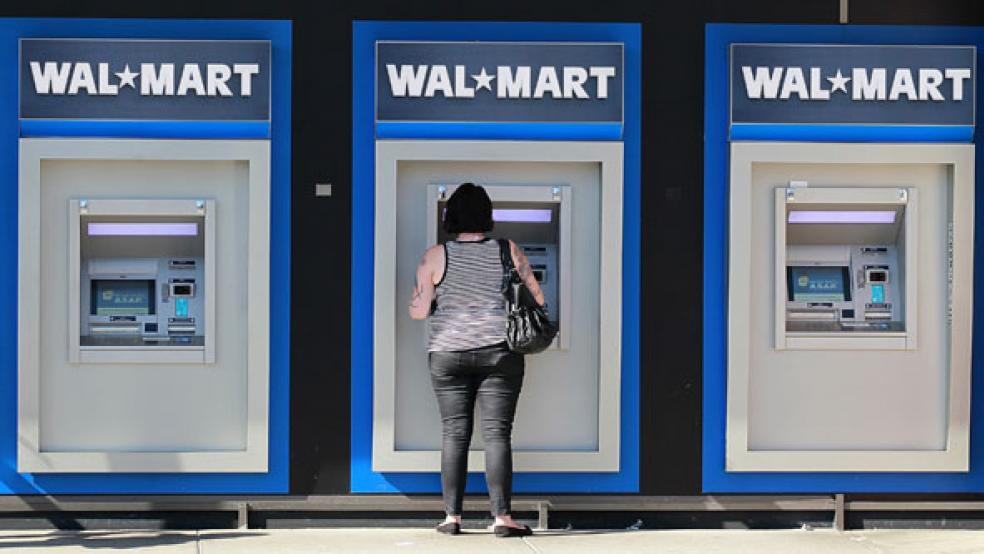Walmart, the retail giant with some 650 stores across the nation, has long raised the hackles of traditional banks by providing financial services to its customers. A few years ago, when the company was pursuing a bank charter, the banking industry did all it could to prevent the company from landing one. The banks succeeded in blocking Walmart’s bid. Now, they may be regretting that.
Today, with Walmart stores offering customers low-cost financial services without the burden of federal banking regulations, bankers are claiming the competition is unfair. They have seized on pending regulations from the fledgling Consumer Financial Protection Bureau as a means of leveling the playing field.
The new agency, established as part of last year’s Dodd-Frank Act, is tasked with identifying “larger participants” in the market for consumer financial products, and regulating those companies’ offerings. A pending rule, which would clarify which companies do and don’t get regulated, has elicited a deluge of comments.
The ruling won’t be determined until the bureau has a director confirmed by the Senate – and President Obama’s nominee, Richard Cordray, is currently facing a Republican filibuster. But that hasn’t stopped both sides from weighing in on which companies should be regulated. Bankers say that subjecting Walmart to CFPB oversight is only fair, and have been lobbying to make sure that the rule is written in such a way that it would cover the giant retailer.
“There is a cost to regulation,” says former banker Terry Jorde, now senior vice president and chief of staff at the Independent Community Bankers of America. “Anybody providing the same services as a bank should be regulated the same way a bank is regulated.”
The 12-Year War
The battle between the banks and Walmart goes back more than a decade. Starting in 1999, when Walmart tried to buy a savings bank in Oklahoma, bankers rallied to oppose the deal. For its part, the retailer claimed repeatedly that the reason it wanted to have a bank charter was for the access it would get to the bank payments system, which would allow it to reduce its costs for credit card processing. The company pointed out that it didn’t need a bank charter to offer simple transactional services, which it was already beginning to do.
Bankers were having none of it. In the banking press, there were dire warnings that Walmart would drive community banks out of business the same way it had with Mom and Pop retail stores.
The same coalition of bankers rejoined the fight in 2002, when Walmart tried to get a type of modified bank charter for something called an industrial loan company (ILC) in California, and again in 2005 when it attempted to form an ILC in Utah.
Finally, it seemed, the banks won. Walmart simply gave up on the idea of owning a bank — although it continued to provide basic services. Today, after nearly a decade of growth and very little federal or state regulation of Walmart’s growing financial services business, the retail chain’s customers can use in-store financial centers to cash checks, buy money orders, transmit money overseas, pay bills, purchase and refill prepaid debit cards. The services at Walmart are almost uniformly cheaper and more convenient than most banks (money orders, for instance, can be purchased at a self-serve kiosk.) For many of the chain’s customers, the retailer essentially replaces a bank. Walmart still cannot accept deposits and doesn’t make loans, but in terms of serving the day-to-day financial needs of lower-income consumers, that doesn’t much matter.
The problem for banks right now is that with interest rates at historic lows, the spread between the interest they pay on deposits and the interest they earn on loans, the traditional source of banks’ income, has narrowed. As a result, banks are looking more toward transactional services as a way to earn fee income. But what they are finding is that the lower-income consumers—whom they weren’t very interested in a few years ago—have found other options, including Walmart.
The company does not provide detailed information about the profits earned by its financial services operation. However, Jane Thompson, who retired in June after running Walmart’s financial services operations for nine years, told the American Banker that the business unit had earned the company “many hundreds of millions of dollars” during her time there.
So after fighting for years to make sure that Walmart wouldn’t become a bank, the financial services industry wants the federal government to regulate Walmart more like…well…a bank. The irony is most certainly not lost on those who criticized bankers’ rabid opposition to granting Walmart a bank charter. “If Walmart had gotten a bank charter then they would already have been roped in,” said Bert Ely, a banking industry consultant in Alexandria, Va.
Ely had argued, back when Walmart was first angling for a charter, that banks were wasting their energy opposing it. He pointed out at the time that the likelihood that Walmart would attempt the massive task of creating and rolling out a nationwide system for accepting deposits and underwriting loans was practically nonexistent. But bankers disagreed, and beat back the charter applications.
Whether CFPB oversight will have a significant impact on Walmart’s operations remains to be seen, but bankers can at least take a lesson from the 12-year running battle: Be careful what you wish for.




